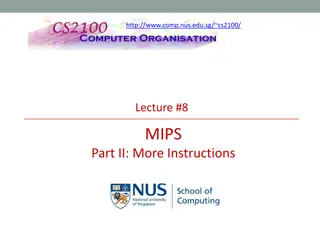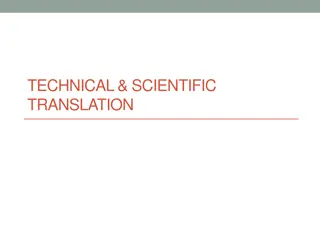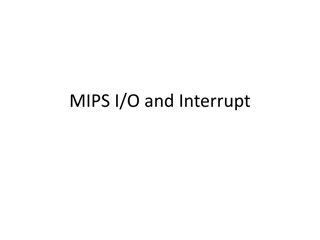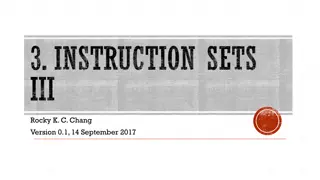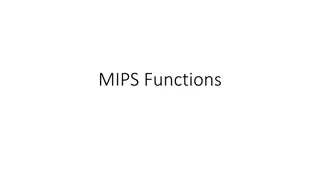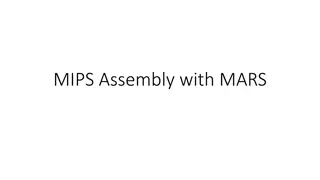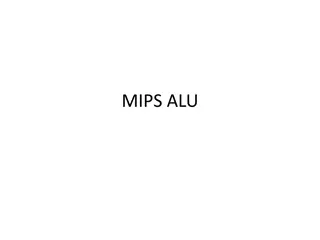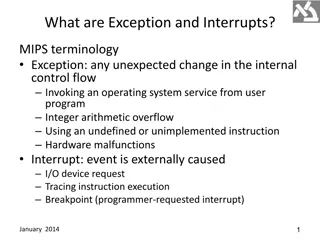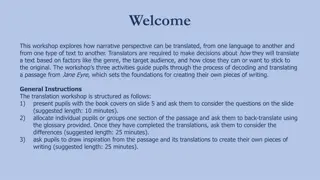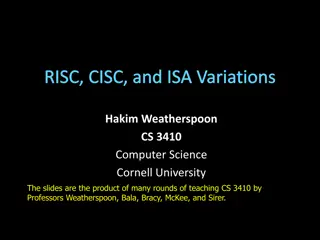Translating Between C and MIPS Problems
In this content, you will find a series of problems that involve translating code snippets between C and MIPS assembly language. The exercises cover scenarios where variables are assigned to registers, base addresses of arrays are provided, and operations are performed using different MIPS instructions. Each problem is accompanied by a solution in the form of corresponding MIPS assembly code or C statements. Explore these exercises to enhance your understanding of translating code between C and MIPS.
Uploaded on Feb 18, 2025 | 0 Views
Download Presentation

Please find below an Image/Link to download the presentation.
The content on the website is provided AS IS for your information and personal use only. It may not be sold, licensed, or shared on other websites without obtaining consent from the author.If you encounter any issues during the download, it is possible that the publisher has removed the file from their server.
You are allowed to download the files provided on this website for personal or commercial use, subject to the condition that they are used lawfully. All files are the property of their respective owners.
The content on the website is provided AS IS for your information and personal use only. It may not be sold, licensed, or shared on other websites without obtaining consent from the author.
E N D
Presentation Transcript
SOLUTIONS CHAPTER 2
EXERCISE 2.4 The following problems deal with translating from C to MIPS. Assume that the variables f, g, h, i, and j are assigned to registers $s0, $s1, $s2, $s3, and $s4, respectively. Assume that the base address of the arrays A and B are in registers $s6 and $s7, respectively. a. f = -g - A[4]; b. B[8] = A[i - j]
2.4.1 For the C statement above, what is the corresponding MIPS assembly code? Solution: a. lw $s0, 16($s6) sub $s0, $0, $s0 sub $s0, $s0, $s1 b. sub $t0, $s3, $s4 slli $t0, $t0, 2 add $t0, $s6, $t0 lw $t1, 0($t0) sw $t1, 32($s7)
2.4.2 For the C statements above, how many MIPS assembly instructions are needed to perform the C statement? Solution: a. 3 b. 5
2.4.3 For the C statement above, how many different registers are needed to carry out the C statement? Solution: a. 3 b. 6
The following problems deal with translating from MIPS to C. Assume that the variables f, g, h, i, and j are assigned to registers $s0, $s1, $s2, $s3, and $s4, respectively. Assume that the base address of the arrays A and B are in registers $s6 and $s7, respectively. a. slli $s2, $s4, 1 // h=j*2 add $s0, $s2, $s3 // f=j*2+i add $s0, $s0, $s1 // f=j*2+i+g b. add $t0, $s6, $s0 //t0= &A[f/4] add $t1, $s7, $s1 // t1= &B[g/4] lw $s0, 0($t0) //s0= A[f/4] addi $t2, $t0, 4 //t2= &A[f/4+1] lw $t0, 0($t2) // t0= A[f/4+1] add $t0, $t0, $s0 // t0= A[f/4]+ A[f/4+1] sw $t0, 0($t1) // B[g/4]= A[f/4]+ A[f/4+1]
2.4.4 For the MIPS assembly instructions above, what is the corresponding C statement? Solution: a. f = 2j + i + g; b. B[g] = A[f] + A[1+f];
2.4.5 For the MIPS assembly instructions above, rewrite the assembly code to minimize the number if MIPS instructions (if possible) needed to carry out the same function. Solution: a. slli $s2, $s4, 1 add $s0, $s2, $s3 add $s0, $s0, $s1 b. add $t0, $s6, $s0 add $t1, $s7, $s1 lw $s0, 0($t0) lw $t0, 4($t0) add $t0, $t0, $s0 sw $t0, 0($t1)
2.4.6 How many registers are needed to carry out the MIPS assembly as written above? If you could rewrite the code above, what is the minimal number of registers needed? Solution: a. 5 as written, 5 minimally b. 7 as written, 6 minimally
EXERCISE 2.6 The following problems deal with translating from C to MIPS. Assume that the variables f, g, h, i, and j are assigned to registers $s0, $s1, $s2, $s3, and $s4, respectively. Assume that the base address of the arrays A and B are in registers $s6 and $s7, respectively. Assume that the elements of arrays A and B are 4-byte words: a. f = -g+h+B[1] b. f=A[B[g]+1]
2.6.1 For the C statement above, what is the corresponding MIPS assembly code? Solution: a. lw $t0, 4($s7) # $t0 <-- B[1] sub $t0, $t0, $s1 add $s0, $t0, $s2 b. sll $t0, $s1, 2 # $t0 <-- 4*g add $t0, $t0, $s7 # $t0 <-- Addr(B[g]) lw $t0, 0($t0) # $t0 <-- B[g] addi $t0, $t0, 1 # $t0 <-- B[g]+1 sll $t0, $t0, 2 # $t0 <-- 4*(B[g]+1) = Addr(A[B[g]+1]) add $t0, $t0, $s6 lw $s0, 0($t0) # f <-- A[B[g]+1] # $t0 <-- B[1] g # f <-- B[1] g + h
2.6.2 For the C statements above, how many MIPS assembly instructions are needed to perform the C statement? Solution: a. 3 b. 6
2.6.3 For the C statements above, how many registers are needed to carry out the C statement using MIPS assembly code? Solution: a. 5 b. 4
The following problems deal with translating from MIPS to C. The following problems deal with translating from C to MIPS. Assume that the variables f, g, h, i, and j are assigned to registers $s0, $s1, $s2, $s3, and $s4, respectively. Assume that the base address of the arrays A and B are in registers $s6 and $s7, respectively. a. sub $s0, $s0, $s1 sub $s0, $s0, $s3 add $s0, $s0, $s1 b. addi $t0, $s6, 4 add $t1, $s6, $0 sw $t1, 0($t0) lw $t0, 0($t0) add $s0, $t1, $t0
The following problems deal with translating from MIPS to C. The following problems deal with translating from C to MIPS. Assume that the variables f, g, h, i, and j are assigned to registers $s0, $s1, $s2, $s3, and $s4, respectively. Assume that the base address of the arrays A and B are in registers $s6 and $s7, respectively. a. sub $s0, $s0, $s1 // f=f-g sub $s0, $s0, $s3 // f=f-g-i add $s0, $s0, $s1 //f=f-i b. addi $t0, $s6, 4 // t0=&(A[1]) add $t1, $s6, $0 // t1=&A[0] sw $t1, 0($t0) // A[1]= &A[0] lw $t0, 0($t0) // t0=&A[0] add $s0, $t1, $t0 // f0=&A[0]+&A[0]
2.6.4 For the MIPS assembly instructions above, what is the corresponding C statement? Solution: a. f = f i; b. f = 2 * (&A);
2.6.5 For the MIPS assembly above, assume that the registers $s0, $s1, $s2, and $s3 contain the values 0x0000000a, 0x00000014, 0x0000001e, and 0x00000028, respectively. Also, assume that register $s6 contains the value 0x00000100, and that memory contains the following values: Address 0x00000100 0x00000104 0x00000108 Value 0x00000064 000000c8 0000012c Find the value of $s0 at the end of the assembly code. Solution: a. $s0 = 30 // add $s0, $s0, $s1 //f=f-i b. $s0 = 512 //f0=&A[0]+&A[0]
2.6.6 For each MIPS instruction, show the value of the opcode(OP), source register(RS), and target register(RT) fields. For the I-type instructions, show the value of the immediate field, and for the R-type instructions, show the value of the desination register(RD) field. Solution: a Type sub $s0,$s0, $s1 R-type sub $s0, $s0, $s3 R-type add $s0, $s0, $s1 R-type opcode 0 0 0 rs 16 16 16 rt 17 19 17 rd 16 16 16 immed b Type I-type R-type I-type I-type R-type opcode 8 0 43 35 0 rs 22 22 8 8 9 rt 8 0 9 8 8 rd immed 4 addi $t0, $s6, 4 add $t1, $s6, $0 sw $t1, 0($t0) lw $t0, 0($t0) add $s0, $t1, $t0 9 0 0 16
EXERCISE 2.14 The following figure shows the placement of a bit field in register $t0. 31 i, i-1 j,j-1 0 Field 32 - i bits i j bits j bits In the following problems, you will be asked to write MIPS instructions to extract the bits Field from register $t0 and place them into register $t1 at the location indicated in the following table. 31 31 (i - j) a 0 Field 0 0 0 0 0 0 14 + i j bits 31 14 0 b 1 1 1 1 1 1 Field 1 1 1 1 1 1
2.14.1 Find the shortest sequence of MIPS instructions that extracts a field from $t0 for the constant values i = 22 and j = 5 and places the field into $t1 in the format shown in the data table. Solution: a. lui $t1, 0x003f // ori $t1, $t1, 0xffe0 and $t1, $t0, $t1 srl $t1, $t1, 5 b. lui $t1, 0x003f (reverse the pattern) ori $t1, $t1, 0xffe0 or $t1, $t0, $t1 sll $t1, $t1, 9
2.14.2 Find the shortest sequence of MIPS instructions that extracts a field from $t0 for the constant values i = 4 and j = 0 and places the field into $t1 in the format shown in the data table. Solution: a. add $t1, $t0, $0 sll $t1, $t1, 28 b. andi $t0, $t0, 0x000f sll $t0, $t0, 14 ori $t1, $t1, 0x3fff sll $t1, $t1, 18 ori $t1, $t1, 0x3fff or $t1, $t1, $t0
2.14.3 Find the shortest sequence of MIPS instructions that extracts a field from $t0 for the constant values i = 31 and j = 28 and places the field into $t1 in the format shown in the data table. Solution: a. srl $t1, $t0, 28 sll $t1, $t1, 29 b. srl $t0, $t0, 28 andi $t0, $t0, 0x0007 sll $t0, $t0, 14 ori $t1, $t1, 0x7fff sll $t1, $t1, 17 ori $t1, $t1, 0x3fff or $t1, $t1, $t0
In the following problems, you will be asked to write MIPS instructions to extract the bits Field from register $t0 shown in the figure and place them into register $t1 at the location indicated in the following table. The bits shown as XXX are to remain unchanged. 31 (i - j) 31 0 Field X X X X X X a 14 + i j bits 31 14 0 b X X X X X X Field X X X X X X
2.14.4 Find the shortest sequence of MIPS instructions that extracts a field from $t0 for the constant values i = 17 and j = 11 and places the field into $t1 in the format shown in the data table. Solution: a. srl $t0, $t0, 11 sll $t0, $t0, 26 ori $t2, $0, 0x03ff sll $t2, $t2, 16 ori $t2, $t2, 0xffff and $t1, $t1, $t2 or $t1, $t1, $t0
2.14.4 Find the shortest sequence of MIPS instructions that extracts a field from $t0 for the constant values i = 17 and j = 11 and places the field into $t1 in the format shown in the data table. Solution: b. srl $t0, $t0, 11 sll $t0, $t0, 26 srl $t0, $t0, 12 ori $t2, $0, 0xfff0 sll $t2, $t2, 16 ori $t2, $t2, 0x3fff and $t1, $t1, $t2 or $t1, $t1, $t0
2.14.5 Find the shortest sequence of MIPS instructions that extracts a field from $t0 for the constant values i = 5 and j = 0 and places the field into $t1 in the format shown in the data table. Solution: a. sll $t0, $t0, 27 ori $t2, $0, 0x07ff sll $t2, $t2, 16 ori $t2, $t2, 0xffff and $t1, $t1, $t2 or $t1, $t1, $t0
2.14.5 Find the shortest sequence of MIPS instructions that extracts a field from $t0 for the constant values i = 5 and j = 0 and places the field into $t1 in the format shown in the data table. Solution: b. sll $t0, $t0, 27 srl $t0, $t0, 13 ori $t2, $0, 0xfff8 sll $t2, $t2, 16 ori $t2, $t2, 0x3fff and $t1, $t1, $t2 or $t1, $t1, $t0
2.14.6 Find the shortest sequence of MIPS instructions that extracts a field from $t0 for the constant values i = 31 and j = 29 and places the field into $t1 in the format shown in the data table. Solution: a. srl $t0, $t0, 29 sll $t0, $t0, 30 ori $t2, $0, 0x3fff sll $t2, $t2, 16 ori $t2, $t2, 0xffff and $t1, $t1, $t2 or $t1, $t1, $t0
2.14.6 Find the shortest sequence of MIPS instructions that extracts a field from $t0 for the constant values i = 31 and j = 29 and places the field into $t1 in the format shown in the data table. Solution: b. srl $t0, $t0, 29 sll $t0, $t0, 30 srl $t0, $t0, 16 ori $t2, $0, 0xffff sll $t2, $t2, 16 ori $t2, $t2, 0x3fff and $t1, $t1, $t2 or $t1, $t1, $t0
EXERCISE 2.20 This exercise deals with recursive procedure calls. For the following problems, the table has an assembly code fragment that computes the factorial of a number. However, the entries in the table have errors, and you will be asked to fix these errors. For number n, factorial of n = 1 2 3 n.
b.FACT: addi $sp, $sp, 8 sw $ra, 4($sp) sw $a0, 0($sp) add $s0, $0, $a0 slti $t0, $a0, 2 beq $t0, $0, L1 mul $v0, $s0, $v0 addi $sp, $sp, -8 jr $ra L1: addi $a0, $a0, -1 jal FACT addi $v0, $0, 1 lw $a0, 0($sp) lw $ra, 4($sp) addi $sp, $sp, -8 jr $ra a.FACT: sw $ra, 4($sp) sw $a0, 0($sp) addi $sp, $sp, -8 slti $t0, $a0, 1 beq $t0, $0, L1 addi $v0, $0, 1 addi $sp, $sp, 8 jr $ra L1: addi $a0, $a0, -1 jal FACT addi $sp, $sp, 8 lw $a0, 0($sp) lw $ra, 4($sp) mul $v0, $a0, $v0 jr $ra
2.20.1 The MIPS assembly program above computes the factorial of a given input. The register input is passed through register $a0, and the result is returned in register $v0. In the assembly code, there are a few errors. Correct the MIPS errors.
Solution: a. FACT: addi $sp, $sp, 8 sw $ra, 4($sp) sw $a0, 0($sp) # save the argument n slti $t0, $a0, 1 # $t0 = $a0 x 2 beq, $t0, $0, L1 # if $t0 = 0, goto L1 add $v0, $0, 1 # return 1 add $sp, $sp, 8 # pop two items from the stack jr $ra # return to the instruction after jal L1: addi $a0, $a0, 1 # subtract 1 from argument jal FACT # call fact(n 1) lw $a0, 0($sp) # just returned from jal: restore n lw $ra, 4($sp) # restore the return address add $sp, $sp, 8 # pop two items from the stack mul $v0, $a0, $v0 # return n*fact(n 1) jr $ra # return to the caller # make room in stack for 2 more items # save the return address
Solution: b. FACT: addi $sp, $sp, 8 # make room in stack for 2 more items sw $ra, 4($sp) # save the return address sw $a0, 0($sp) # save the argument n slti $t0, $a0, 1 # $t0 = $a0 x 2 beq, $t0, $0, L1 # if $t0 = 0, goto L1 add $v0, $0, 1 # return 1 add $sp, $sp, 8 # pop two items from the stack jr $ra # return to the instruction after jal L1: addi $a0, $a0, 1 # subtract 1 from argument jal FACT # call fact(n 1) lw $a0, 0($sp) # just returned from jal: restore n lw $ra, 4($sp) # restore the return address add $sp, $sp, 8 # pop two items from the stack mul $v0, $a0, $v0 # return n*fact(n 1) jr $ra # return to the caller
2.20.2 For the recursive factorial MIPS program above, assume that the input is 4. Rewrite the factorial program to operate in a non-recursive manner. Restrict your register usage to registers $s0-$s7. What is the total number of instructions used to execute your solution from 2.20.2 versus the recursive version of the factorial program?
Solution: a. 25 MIPS instructions to execute non-recursive vs. 45 instructions to execute (corrected version of) recursion Non-recursive version: FACT: addi $sp, $sp, 4 sw $ra, 4($sp) add $s0, $0, $a0 add $s2, $0, $1 LOOP: slti $t0, $s0, 2 bne $t0, $0, DONE mul $s2, $s0, $s2 addi $s0, $s0, 1 j LOOP DONE: add $v0, $0, $s2 lw $ra, 4($sp) addi $sp, $sp, 4 jr $ra
Solution: b. 25 MIPS instructions to execute non-recursive vs. 45 instructions to execute (corrected version of) recursion Non-recursive version: FACT: addi $sp, $sp, 4 sw $ra, 4($sp) add $s0, $0, $a0 add $s2, $0, $1 LOOP: slti $t0, $s0, 2 bne $t0, $0, DONE mul $s2, $s0, $s2 addi $s0, $s0, 1 j LOOP DONE: add $v0, $0, $s2 lw $ra, 4($sp) addi $sp, $sp, 4 jr $ra
2.20.3 Show the contents of the stack after each function call, assuming that the input is 4.
Solution: a. Recursive version FACT: addi $sp, $sp, 8 sw $ra, 4($sp) sw $a0, 0($sp) add $s0, $0, $a0 HERE: slti $t0, $a0, 2 beq $t0, $0, L1 addi $v0, $0, 1 addi $sp, $sp, 8 jr $ra L1: addi $a0, $a0, 1 jal FACT mul $v0, $s0, $v0 lw $a0, 0($sp) lw $ra, 4($sp) addi $sp, $sp, 8 jr $ra
Solution: a. at label HERE, after calling function FACT with input of 4: old $sp -> 0xnnnnnnnn ??? 4 $sp-> 8 contents of register $a0 at label HERE, after calling function FACT with input of 3: old $sp -> 0xnnnnnnnn 4 8 12 $sp -> 16 contents of register $ra ??? contents of register $ra contents of register $a0 contents of register $ra contents of register $a0
Solution: a. at label HERE, after calling function FACT with input of 2: old $sp -> 0xnnnnnnnn ??? 4 8 12 16 20 $sp -> 24 contents of register $ra contents of register $a0 contents of register $ra contents of register $a0 contents of register $ra contents of register $a0
Solution: a. at label HERE, after calling function FACT with input of 1: old $sp -> 0xnnnnnnnn ??? 4 8 12 contents of register $ra 16 20 24 contents of register $a0 28 $sp -> 32 contents of register $ra contents of register $a0 contents of register $a0 contents of register $ra contents of register $ra contents of register $a0
Solution: b. Recursive version FACT: addi $sp, $sp, 8 sw $ra, 4($sp) sw $a0, 0($sp) add $s0, $0, $a0 HERE: slti $t0, $a0, 2 beq $t0, $0, L1 addi $v0, $0, 1 addi $sp, $sp, 8 jr $ra L1: addi $a0, $a0, 1 jal FACT mul $v0, $s0, $v0 lw $a0, 0($sp) lw $ra, 4($sp) addi $sp, $sp, 8 jr $ra
Solution: b. at label HERE, after calling function FACT with input of 4: old $sp -> 0xnnnnnnnn ??? 4 $sp-> 8 contents of register $a0 at label HERE, after calling function FACT with input of 3: old $sp -> 0xnnnnnnnn 4 8 12 $sp -> 16 contents of register $ra ??? contents of register $ra contents of register $a0 contents of register $ra contents of register $a0
Solution: b. at label HERE, after calling function FACT with input of 2: old $sp -> 0xnnnnnnnn ??? 4 8 12 16 20 $sp -> 24 contents of register $ra contents of register $a0 contents of register $ra contents of register $a0 contents of register $ra contents of register $a0
Solution: b. at label HERE, after calling function FACT with input of 1: old $sp -> 0xnnnnnnnn ??? 4 8 12 contents of register $ra 16 20 24 contents of register $a0 28 $sp -> 32 contents of register $ra contents of register $a0 contents of register $a0 contents of register $ra contents of register $ra contents of register $a0
For the following problems, the table has an assembly code fragment that computes a Fibonacci number. However, the entries in the table have errors, and you will be asked to fix the errors. For number n, the Fibonacci of n is calculated as follows: n Fibonacci of n 1 1 2 1 3 2 4 3 5 5 6 8 7 13 8 21
a. FIB: addi $sp, $sp, -12 sw $ra, 0($sp) sw $s1, 4($sp) sw $a0, 8($sp) slti $t0, $a0, 1 beq $t0, $0, L1 addi $v0, $a0, $0 j EXIT L1: addi $a0, $a0, -1 jal FIB addi $s1, $v0, $0 addi $a0,$a0, -1 jal FIB add $v0, $v0, $s1 EXIT:lw $ra, 0($sp) lw $a0, 8($sp) lw $s1, 4($sp) addi $sp, $sp, 12 jr $ra b. FIB: addi $sp, $sp, -12 sw $ra, 8($sp) sw $s1, 4($sp) sw $a0, 0($sp) slti $t0, $a0, 3 beq $t0, $0, L1 addi $v0, $0, 1 j EXIT L1: addi $a0, $a0, -1 jal FIB addi $a0, $a0, -2 jal FIB add $v0, $v0, $s1 EXIT:lw $a0, 0($sp) lw $s1, 4($sp) lw $ra, 8($sp) addi $sp, $sp, 12 jr $ra
2.20.4 The MIPS assembly program above computes the Fibonacci of a given input. The integer input is passed through register $a0, and the result is returned in register $v0. In the assembly code, there are a few errors. Correct the MIPS errors.
Solution: a. FIB: addi $sp, $sp, 12 sw $ra, 8($sp) sw $s1, 4($sp) sw $a0, 0($sp) slti $t0, $a0, 3 beq $t0, $0, L1 addi $v0, $0, 1 j EXIT L1: addi $a0, $a0, 1 jal FIB addi $s1, $v0, $0 addi $a0, $a0, 1 jal FIB add $v0, $v0, $s1 EXIT: lw $a0, 0($sp) lw $s1, 4($sp) lw $ra, 8($sp) addi $sp, $sp, 12 jr $ra


